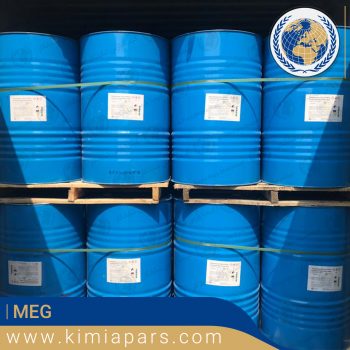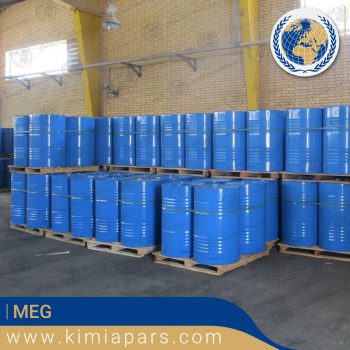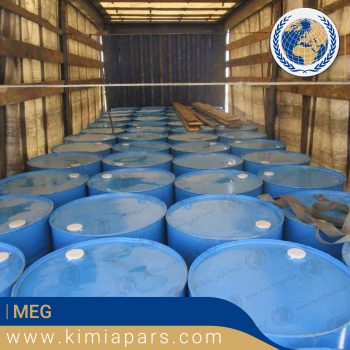Mono Ethylene Glycol 99.8%
- Description
- Analysis of MEG
- Download of Analysis
Description
Mono Ethylene Glycol | MEG
Chemical Formula of Mono Ethylene Glycol: C2H6O2
Other names: Ethylene Alcohol | Hypodicarbonous acid | Ethylene Glycol
Appearance: Clear | Colorless Liquid
Usages: Mono Ethylene glycol is an organic compound that acts as antifreeze and a precursor for polymers used in vehicles placed. Ethylene glycol is used in its pure form, liquid colorless, odorless and poisonous and sweet taste.
Packaging: 220 kg new steel drum
Price: Negotiable, depending on the amount of the order
Payment terms: T/T 100% cash in advance
Min order: 1*20 ft. FCL
Delivery time: Within 5-10 days after we receive the payment
Origin: Iran
Monoethylene Glycol (MEG) is a colorless, odorless, and hygroscopic liquid that is soluble in water and used in various industrial applications. It is commonly known as ethylene glycol and is a chemical compound with the formula C2H6O2. MEG is the simplest of the glycols, a family of chemicals that play a vital role in modern life.
MEG is produced from the reaction of ethylene oxide and water, and it is the starting material for the manufacture of polyethylene terephthalate (PET) resin, which is widely used in the production of plastic bottles, packaging materials, and textiles. MEG is also used as a coolant and heat transfer fluid in the automotive and HVAC industries, and it is an ingredient in antifreeze, de-icing solutions, and personal care products.
The largest consumer of MEG is the polyester fiber industry, where it is used as a starting material to produce polyethylene terephthalate (PET) resin. PET is used to produce synthetic fibers and resins that have applications in a wide range of industries, including textiles, packaging, and consumer goods. The demand for PET is expected to grow as a result of the increasing demand for lightweight, strong, and durable materials in various applications.
MEG is also used as a coolant and heat transfer fluid in a variety of industries. In the automotive industry, it is used in engine coolant, radiator coolant, and brake fluid, and it is an essential component of antifreeze and de-icing solutions. MEG has a low freezing point and high boiling point, which makes it ideal for use in these applications.
In the HVAC industry, MEG is used in air-conditioning and refrigeration systems as a coolant and heat transfer fluid. It has a low toxicity, which makes it safe for use in these applications. MEG has a high thermal conductivity, which makes it an efficient heat transfer fluid, and it is also a good conductor of electricity, which makes it an effective refrigerant.
MEG is also used as an ingredient in a variety of personal care products, such as toothpaste, mouthwash, and cosmetics. It is a humectant, which means it helps to retain moisture, and it is also a solvent, which makes it an effective ingredient for dissolving other ingredients. MEG is a non-irritant, which makes it a suitable ingredient for use in personal care products that come into contact with the skin.
In addition to its uses in various industries, MEG has a number of environmental and safety considerations. MEG is a highly flammable liquid, and it should be handled and stored with care to prevent fires and explosions. It is also toxic when ingested, and it can cause serious health problems if it is not handled or stored properly.
MEG is also an environmental contaminant, and it can have a significant impact on aquatic ecosystems. When MEG is released into the environment, it is biodegraded by microorganisms into toxic by-products, such as glycolic acid and formaldehyde. These by-products can be harmful to aquatic life and can have a significant impact on the health of aquatic ecosystems.
Despite its environmental and safety considerations, MEG continues to be an essential chemical in a wide range of industries, and its demand is expected to grow in the future. The increasing demand for lightweight, strong, and durable materials, combined with the growing demand for cooling and refrigeration systems, is expected to drive the demand for MEG in the future.
MEG Analysis |
| Content | Test Result |
|---|---|
| Purity | Min 99.8% wt% |
| Water Content | Min 0.08% wt% |
| Acidity | Max 10 mg/kg |
| ASH | Max 50 mg/kg |
| DEG | Min 0.08 wt % |
| Aldehydes | Max 8 mg/kg |
| Color, Pt-Co | Max 5 |
| Inorganic chlorides | Max 0.05 mg/kg |
| Iron | Max 0.1 mg/kg |
| Sp.Gr. (20/20°C) | 1.1151- 1.1156 |




